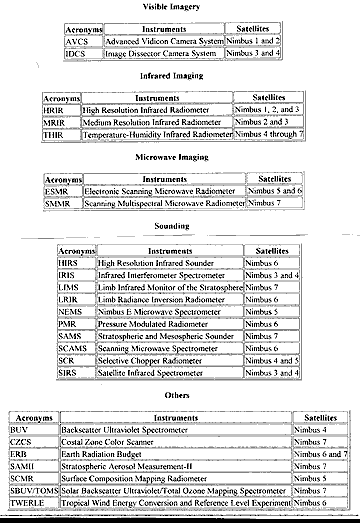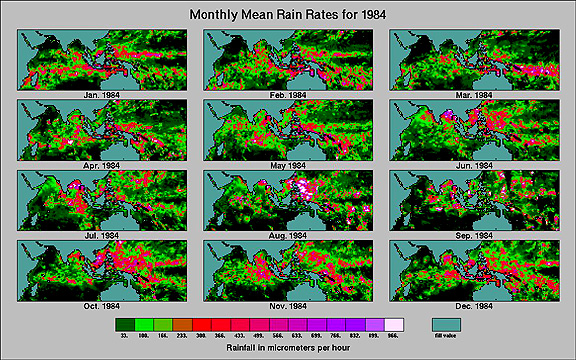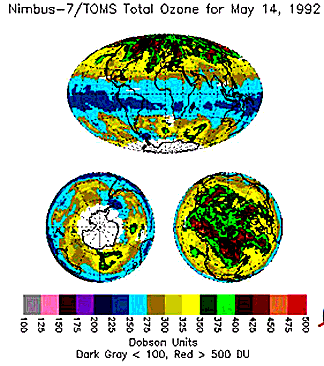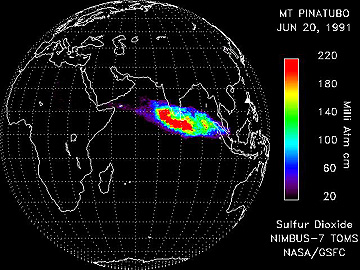The United States metsat program traces its inception to the launch of Vanguard 2 in February of 1959, just 12 months after its first ever successful satellite, Explorer 1. The spacecraft failed because of a wobbly orbit. An improper orbit on the next attempt, with Explorer 6, led to a few low resolution pictures of the Earth. Success was achieved on Explorer 7, orbited on October 13, 1959, which carried a radiometer designed by Verner Suomi, America's pioneer in satellite meteorology, and his colleagues. Using black and white hemispheres, this instrument measured both solar and terrestrial radiative energy (determining both reflective and absorbed components) to estimate radiation balance.
TIROS-2 included MRIR (Medium Resolution Infrared Radiometer);
the TIROS-8 vidicon had an 800-line resolution and was the first
to use the APT (Automatic Picture Transmission) technique. The
TIROS series (10 in all) was non-polar following inclinations
relative to the equator between 48 and 58°. The first 8 TIROS
maintained orientation by spinning at 12 revolutions/minute which
limited the time during which the camera pointed at the Earth.
TIROS-9 followed a "cartwheel" spin pattern (spin axis perpendicular
to the orbital plane) which facilitated coverage to allow strips
of images that could be mosaicked to provide global composites:
The next fleet of metsats, the Nimbus series (total of 7), was
dedicated largely to research and development experiments. The
instruments used in this series are named in this Table.

Nimbus-1, launched on August 28, 1964, was the first to be placed
in a sun-synchronous orbit (now the norm); it used a 3-axis stabilization
technique (based on flywheels) that kept it pointed constantly
at Earth. It carried several instruments including the AVCS (an
APT) vidicon and the HRIR (High Resolution Infrared Radiometer)
which operated in 3.6 - 4.2 µm interval. An example of a Nimbus
1 HRIR image, taken at night over western Europe, appears on the
top (note the distortion that enlarges Germany and Sweden
relative to southern countries - the Italians might be aggrieved
by the shrinking of the "boot"); on the bottom is a visible (IDCS)
image of the southeast U.S. seen by Nimbus 3:
To compare the information obtained in the visible (left) and
the thermal infrared, look at this image pair of the Gulf of Mexico
acquired simultaneously by Nimbus 4.
It is instructive to get a feel for what can be seen on land surfaces
at the 1.1 km (0.7 mile) resolution provided by the IDCS visible
channel on Nimbus 3. Under optimal viewing conditions, parts of
Wyoming and Utah appear here (this scene was the first space imagery
ever worked on by the writer [NMS] in 1970).
The basins generally are highly reflective; the mountains tend to stand apart because of dark tones associated with evergreen vegetation. Compare this image with the Landsat 1 MSS image of the Wind River Mountains (upper right in the Nimbus view) in Section 2 .
Nimbus 3 (April 14, 1969) also was the first to make extensive use of atmospheric sounders, with its IRIS (Infrared Interferometer Spectrometer) operating between 6 and 25 µm and SIRS (Satellite Infrared Spectrometer) sensing in the 15 µm region. Nimbus 4 (April 8, 1970) carried the BUV (Backscatter Ultraviolet) radiometer, becoming the first metsat to measure atmospheric ozone.
Two instruments on Nimbus 5 (December 11, 1972) are of special
significance. The Surface Composition Mapping Radiometer (SCMR)
utilizes two thermal bands, 8.4 - 9.5 µm and 10.2 - 11.4 µm, to
produce color-coded temperature maps such as this image of Florida
and Cuba and surrounding waters, made from the 8.8 µm channel:
Ratios of radiant temperatures measured by the two bands provide a qualitative estimate of SiO2 content of rocks and soils. This uses the concept of "restrahlen", a German term that refers to decreased emissivity (a parameter mentioned in Section 9) owing to resonance vibrations associated with silicon-oxygen bonds in silica tetrahedra. An emissivity trough shifts towards longer wavelengths as silica content increases.
The ESMR (Electronically Scanning Microwave Radiometer) on Nimbus-5
operated at a 19.35 GHz frequency (1.55 cm wavelength) to sense
brightness temperatures of the surface and atmosphere. This instrument
is capable of fixing surface ice temperatures, especially in the
polar regions, as shown in this time series of maps that plot
the percentage of ice cover around Antarctica on a monthly basis
in 1974. ESMR was also the first to use microwave absorption to
estimate precipitation (rain rates) by quantifying increases in
optical depth correlative to higher brightness temperatures. The
ESMR on Nimbus 6 (June 12, 1975) was set at 37 GHz (0.81 cm).
SMMR, the Scanning Multichannel Microwave Radiometer flown on
Nimbus 7 (October 24, 1978), and again on Seasat, consists of
a 5-channel (0.81, 1.36, 1.66, 2.80, 4.54 cm), dual-polarization
instrument that provides data of value to many applications: ocean
circulation, low altitude winds, water vapor, cloud liquid water
content, sea ice type, extent, and concentration, snow cover and
moisture, and rainfall rates. Data on tropical rainfall for the
months of 1986 over the Indian Ocean and South Asia is one such
product:

Ice in the Antarctic shelf was monitored by SMMR during 1985,
as displayed for four months here:

The first Total Ozone Mapping Spectrometer (TOMS), on Nimbus 7
which is still operating, measures UV reflectivities at 0.312,
0.317, 0.331, and 0.340 µm. Ozone is calculated from the ratio
of 0.312/0.331 µm. As an example of a global ozone map, here is
the plot of data obtained on May 14,1992.

(Note: A Dobson unit is the response from a compressed column of ozone equivalent to a 0.01 mm. thick measured over a fixed area centered on Labrador in eastern Canada.)
TOMS can also be used to monitor SO2 in the atmosphere. After some major volcanic eruptions, extensive
clouds of SO2-enriched ash and gases injected into the upper atmosphere can
be tracked daily across much of the world until they dissipate
below detection. Here is the status on June 20, 1991 of the cloud
produced by the Mt. Pinatubo eruption in the Philippines.

The first SBUV (Solar Backscatter UltraViolet) was on Nimbus 7 (also on NOAA-9 and 11), sharing some of the components of the TOMS. SBUV had 12 channels in the UV. The Coastal Zone Color Scanner (CZCS), which flew exclusively on Nimbus 7 is discussed in some detail later in this Section.
Code 935, Goddard Space Flight Center, NASA
Written by: Nicholas M. Short, Sr. email: nmshort@epix.net
and
Jon Robinson email: Jon.W.Robinson.1@gsfc.nasa.gov
Webmaster: Bill Dickinson Jr. email: rstwebmaster@gsti.com
Web Production: Christiane Robinson, Terri Ho and Nannette Fekete
Updated: 1999.03.15.